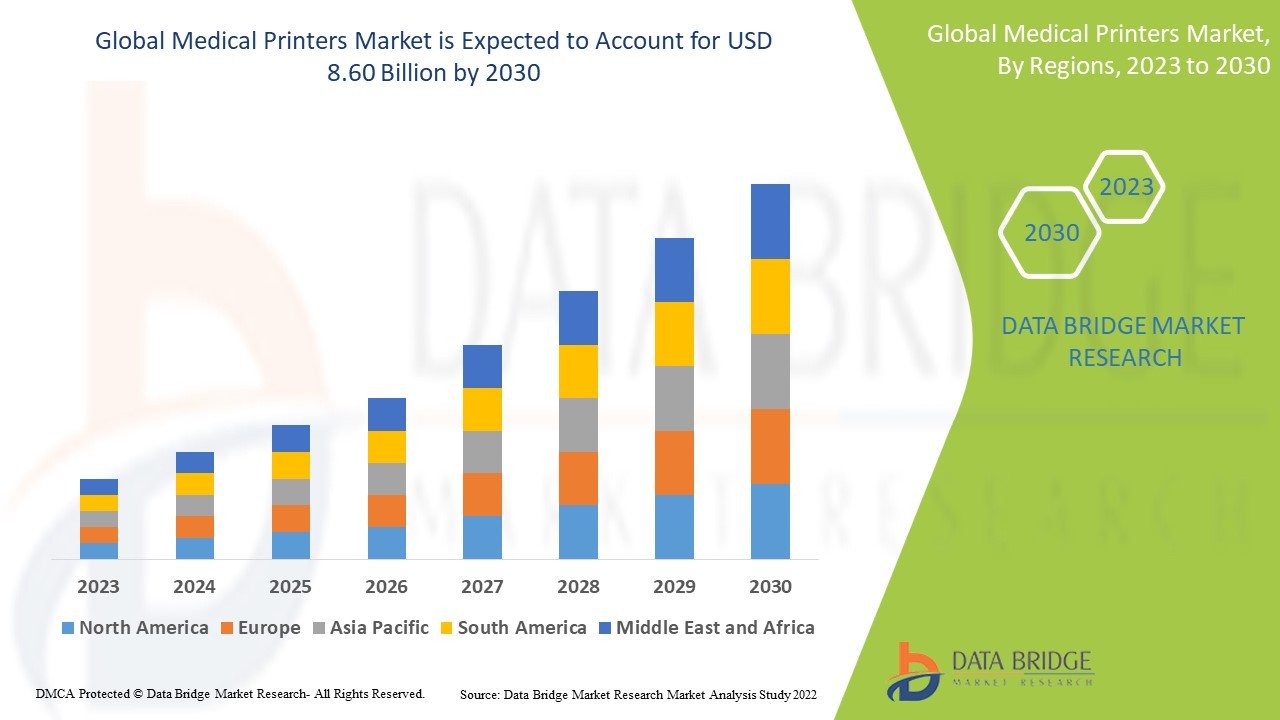Introduction
Medical printers play a crucial role in modern healthcare, providing high-quality imaging, documentation, and 3D printing solutions for medical applications. These printers are used in hospitals, diagnostic centers, and research institutions to print medical records, patient reports, and 3D anatomical models for surgeries and prosthetics.
To Know More Visit: https://www.databridgemarketresearch.com/reports/global-medical-printers-market
The demand for medical printers has surged with the advancement of healthcare technologies, the rise in chronic diseases, and the increasing need for precise medical imaging. The market is expanding due to continuous innovations, government support, and growing adoption of digital healthcare solutions.
This article explores the evolution of the medical printers market, emerging trends, factors influencing growth, market share analysis, and segmentation of the industry.
The Evolution of the Medical Printers Market
The medical printers market has evolved significantly over the past few decades. Initially, medical facilities relied on traditional printing methods for documentation and imaging. The introduction of digital printing technology transformed medical record-keeping, reducing errors and improving efficiency.
With the emergence of advanced imaging techniques, medical printers have become essential for printing high-resolution radiology images, pathology reports, and surgical guides. The rise of 3D printing in healthcare has further revolutionized the market, enabling the creation of patient-specific prosthetics, implants, and anatomical models.
Today, medical printers offer high-speed, precision printing solutions for various medical applications. Companies are investing in research and development to enhance printer capabilities, improve print quality, and expand their applications in personalized medicine.
Market Trends
The medical printers market is witnessing rapid changes due to technological advancements, increased demand for digital healthcare solutions, and improved medical imaging techniques. Some key trends shaping the industry include:
- Growth of 3D Printing in Healthcare: The increasing use of 3D printing for prosthetics, organ models, and surgical planning is driving market expansion.
- Rising Adoption of Digital Imaging: The transition from conventional film-based imaging to digital printing is enhancing efficiency and accuracy in medical diagnostics.
- AI and Automation Integration: Artificial intelligence and automation are being integrated into medical printers for better workflow management and image enhancement.
- Eco-Friendly Printing Solutions: Companies are focusing on sustainable and biodegradable printing materials to reduce environmental impact.
- Increase in Portable and Wireless Printers: The demand for compact, wireless medical printers is rising, allowing easy accessibility and mobility in healthcare settings.
Factors Driving Market Growth
Several factors contribute to the expansion of the medical printers market, including:
- Rising Demand for Medical Imaging: The growing prevalence of chronic diseases and the need for accurate diagnostic imaging have increased the demand for high-quality medical prints.
- Advancements in 3D Printing Technology: The development of advanced 3D printing techniques for personalized prosthetics and organ models is fueling market growth.
- Expansion of Healthcare Facilities: The increasing number of hospitals, diagnostic centers, and research institutions is driving demand for medical printing solutions.
- Government Support and Funding: Various governments and healthcare organizations are investing in digital healthcare infrastructure, boosting the adoption of medical printers.
- Cost-Effectiveness and Efficiency: Medical printers offer cost-effective solutions for printing medical reports, reducing dependency on external printing services.
Market Share Analysis
The medical printers market is highly competitive, with key players leading the industry through technological advancements and strategic partnerships. Some of the major companies in the market include:
- Canon Inc.
- Epson Corporation
- Konica Minolta Inc.
- GE Healthcare
- Siemens Healthineers
- 3D Systems Corporation
- Stratasys Ltd.
These companies are continuously innovating to improve printer efficiency, expand product offerings, and enhance the overall healthcare printing experience. Collaborations with hospitals and research institutions are helping them maintain a strong market presence.
Market Demand
The demand for medical printers is increasing due to several factors, including:
- Growing Need for Efficient Medical Documentation: Healthcare providers require high-speed, accurate printing solutions for medical records and reports.
- Rising Adoption of Telemedicine and Digital Health Records: The shift toward electronic health records (EHRs) is increasing the need for digital and cloud-connected printing solutions.
- Advancements in Surgical Planning: Surgeons use high-quality prints and 3D models for preoperative planning, improving surgical accuracy.
- Increase in Research and Development Activities: Medical research institutions require advanced printing solutions for analyzing and documenting clinical data.
- Customization in Prosthetics and Implants: The demand for patient-specific prosthetics and implants is driving the growth of medical 3D printing solutions.
Market Segmentation
The medical printers market is segmented based on:
1. By Type of Printer
- Inkjet Printers
- Laser Printers
- Thermal Printers
- 3D Printers
2. By Application
- Medical Imaging Printing
- 3D Medical Printing
- Surgical Planning and Prosthetics
- Electronic Health Records Printing
3. By End User
- Hospitals & Clinics
- Diagnostic Centers
- Research Laboratories
- Pharmaceutical & Biotechnology Companies
4. By Region
- North America (United States, Canada)
- Europe (Germany, UK, France)
- Asia-Pacific (China, Japan, India)
- Latin America (Brazil, Mexico)
- Middle East & Africa (South Africa, GCC Countries)
Conclusion
The medical printers market is expanding due to the growing demand for high-quality medical imaging, the rise of 3D printing applications, and advancements in healthcare technology. With continuous research and innovation, the industry is expected to witness significant growth in the coming years.
Leading companies are focusing on developing cost-effective, eco-friendly, and high-precision medical printers to cater to the evolving needs of the healthcare sector. As hospitals and research institutions increasingly adopt digital and 3D printing solutions, the demand for medical printers will continue to rise, shaping the future of medical diagnostics and treatment planning.



